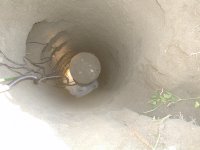GeoAgro soil data collector

I just got back from the 20th Annual Meeting of the NSCSS in San Antonio, TX. Ed DiPollina, TekConsultants, was one of the presenters, and I was very impressed with the potential for a product his company is bringing to market, the GeoAgro Soil Data Collector. Designed for field soil scientists like myself, the Soil Data Collector helps us log soil profile descriptions and geo-reference our field notations, map features & test pit locations in the field on a Tablet PC.
I saw many NSCSS soil scientists sign on as beta testers. Considering the varied applications that field soils data is applied to, this is surely going to be an interesting process.
Similar field data solutions are available to government soil scientists (Pedon PC software was presented to us by USDA-NRCS in San Antonio), but the GeoAgro Soil Data Collector is the first one geared to consulting field soil scientists, arguably a larger and faster growing market than represented by government soil scientists.
It struck me during Ed DiPollina's presentation that the GIS and GPS portion of these types of products is becoming more of a commodity, with the forms and data entry portion holding the interest of the San Antonio audience.
Unlike similar solutions geared to institutional needs, this product will be affordable for the small business to enter into. This is not always a given since GIS solutions vary wildly in price relative to the value provided. If you are already using a GIS product like ESRI's ArcView (ESRI is the world leader in GIS software), no problem, the Soil Data Collector has the ability to export and import different types of files, such as shape, drawing and spreadsheet formats, along with substantial GIS functionality. Don't already have a GIS solution? A simplified non-ESRI solution is being provided.
Speaking of ESRI, affordable alternatives to ESRI products are on the rise. If you are already a locked into being a customer of ESRI, or you are a status quo driven public institution, this will not matter to you. A growing number of us are not. We constitute a market that ESRI has pointedly chosen, through proprietary file formatting and opportunistic pricing, not to serve. I don't fault ESRI for choosing a captive market business model. Its a legit choice. Unfortunately for ESRI, and ultimately ESRI's customers, it is difficult model to adapt to changing market conditions. If the monopolistic aspects of ESRI have escaped you, consider. GIS solutions are simple, ubiquitous, data processing solutions for publicly available georeferenced data. The algorithms used to project the data into only 2 dimensions were constructed long ago by federal agencies using public funds. The math and the data are both freely available to everyone. ESRI doesn't add value to data in the classic meaning of value, it locks it into a proprietary format and holds it for ransom.
A captive market business model smothers the necessity to innovate. Over at competitor Manifold System GIS, several sub$1K solutions are optimized for multiple core CPUs and 64 bit processing. This has been available since August, 2006. ESRI has yet to announce when they intend to provide multi-core or 64 bit functionality, even at the >$120K level. Some generally similar observations about ESRI: (1) (2) (3)
ESRI's loosening grip on the lead and a general increase in GIS software choice and capability are helping to bring innovators like TekConsultants onto the playing field.
Technorati Tags: gis gps pedology soil scientist innovation







